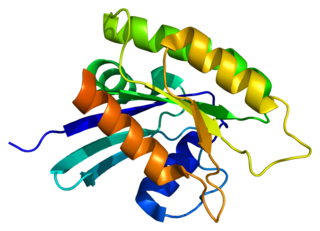Securin is a protein that in humans is encoded by the PTTG1 gene. [5] [6] [7]
Securin is a protein that in humans is encoded by the PTTG1 gene. [5] [6] [7]
The encoded protein is a homolog of yeast securin proteins, which prevent separins from promoting sister chromatid separation. It is an anaphase-promoting complex (APC) substrate that associates with a separin until activation of the APC. The gene product has transforming activity in vitro and tumorigenic activity in vivo, and the gene is highly expressed in various tumors. The gene product contains 2 PXXP motifs, which are required for its transforming and tumorigenic activities, as well as for its stimulation of basic fibroblast growth factor expression. It also contains a destruction box (D box) that is required for its degradation by the APC. The acidic C-terminal region of the encoded protein can act as a transactivation domain. The gene product is mainly a cytosolic protein, although it partially localizes in the nucleus. [7]
PTTG1 has been shown to interact with:
During Mitosis CDK1 phosphorylate PTTG1 at Ser-165. [12] PTTG1 is down-regulated in melanoma cells in response to the cyclin-dependent kinase inhibitor PHA-848125. [13]

An oncogene is a gene that has the potential to cause cancer. In tumor cells, these genes are often mutated, or expressed at high levels.

Cyclin D1 is a protein that in humans is encoded by the CCND1 gene.

MYC proto-oncogene, bHLH transcription factor is a protein that in humans is encoded by the MYC gene which is a member of the myc family of transcription factors. The protein contains basic helix-loop-helix (bHLH) structural motif.

Ku70 is a protein that, in humans, is encoded by the XRCC6 gene.

Krueppel-like factor 6 is a protein that in humans is encoded by the KLF6 gene.

Proto-oncogene Wnt-1, or Proto-oncogene Int-1 homolog is a protein that in humans is encoded by the WNT1 gene.

GDNF family receptor alpha-1 (GFRα1), also known as the GDNF receptor, is a protein that in humans is encoded by the GFRA1 gene.

Proto-oncogene tyrosine-protein kinase Src, also known as proto-oncogene c-Src, or simply c-Src, is a non-receptor tyrosine kinase protein that in humans is encoded by the SRC gene. It belongs to a family of Src family kinases and is similar to the v-Src gene of Rous sarcoma virus. It includes an SH2 domain, an SH3 domain and a tyrosine kinase domain. Two transcript variants encoding the same protein have been found for this gene.

Proto-oncogene vav is a protein that in humans is encoded by the VAV1 gene.

Heterogeneous nuclear ribonucleoproteins C1/C2 is a protein that in humans is encoded by the HNRNPC gene.

Zinc finger protein PLAGL1 is a protein that in humans is encoded by the PLAGL1 gene.

DnaJ homolog subfamily A member 1 is a protein that in humans is encoded by the DNAJA1 gene.

Fibroblast growth factor 4 is a protein that in humans is encoded by the FGF4 gene.

Large tumor suppressor kinase 1 (LATS1) is an enzyme that in humans is encoded by the LATS1 gene.

Lysine-specific demethylase 4A is an enzyme that in humans is encoded by the KDM4A gene.

Ras-related protein M-Ras, also known as muscle RAS oncogene homolog and R-Ras3, is a protein that in humans is encoded by the MRAS gene on chromosome 3. It is ubiquitously expressed in many tissues and cell types. This protein functions as a signal transducer for a wide variety of signaling pathways, including those promoting neural and bone formation as well as tumor growth. The MRAS gene also contains one of 27 SNPs associated with increased risk of coronary artery disease.

40S ribosomal protein S10 is a protein that in humans is encoded by the RPS10 gene.

Large tumor suppressor kinase 2 (LATS2) is an enzyme that in humans is encoded by the LATS2 gene.

Tumor protein D52 is a protein that in humans is encoded by the TPD52L1 gene.

Pituitary tumor-transforming gene 1 protein-interacting protein (PTTG1), also known as PTTG1-binding factor (PBF), is a poorly characterised protein that in humans is encoded by the PTTG1IP gene located within the chromosomal region 21q22.3.